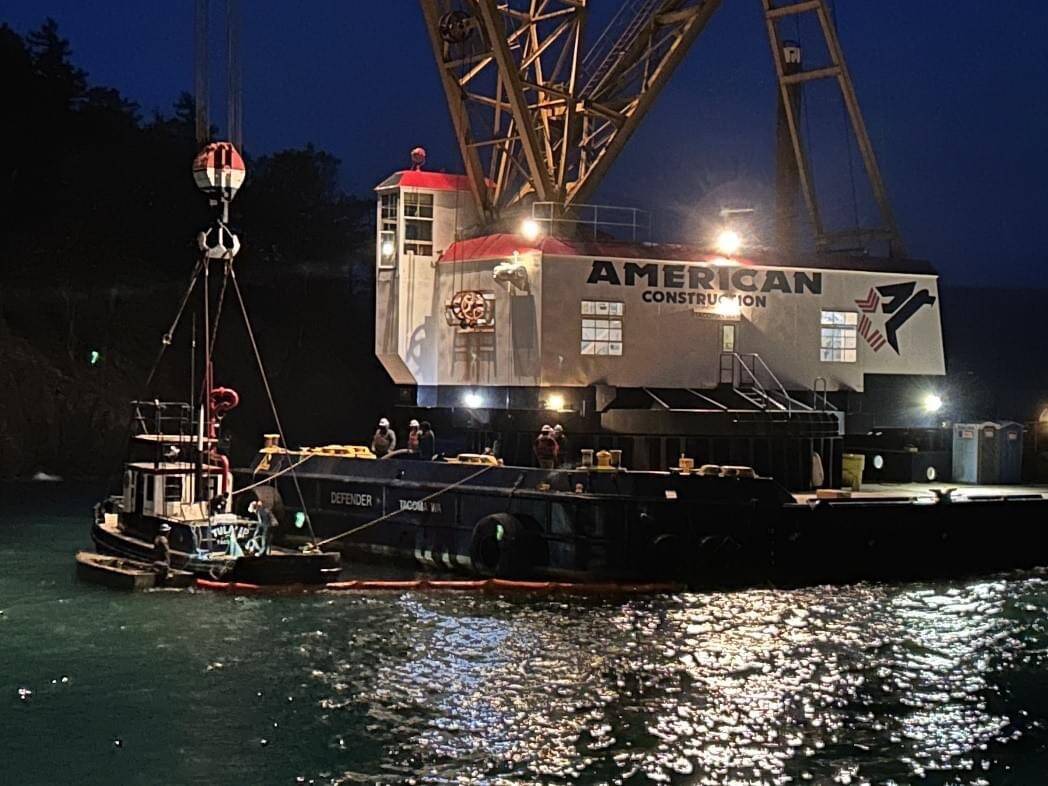A 45-foot tugboat partially sank off the Lopez ferry terminal on Feb. 22, with an estimated 400 gallons of diesel fuel onboard. Initial reports indicated the semi-submerged tug sank in the vicinity of a larger barge operation that was onsite to repair the Lopez ferry dock.
According to Elaina Thompson, the new Executive Director of Islands’ Oil Spill Association, the vessel sinking was reported by American Construction Company, owner of the tug and barge.
“We got a call this morning at 8:45 a.m. that this was happening,” she said. “We sent a responder out on Lopez Island who got eyes on the scene and took some photographs and assessed the weather. We reported that to the Department of Ecology and the US Coast Guard. We confirmed that all the proper channels were notified and responders were en route, and now due to the weather and other factors are taking command from DOE and US Coast Guard and waiting as this unfolds.”
Early Wednesday morning photos taken at the scene showed the vessel’s flybridge was visible above the surface, and a diesel sheen visible drifting towards shore. According to Ty Keltner, Public Information Officer for the Department of Ecology, responders were en route with air quality monitors to assess any diesel vapors. In addition, the response contractor that had been hired was Global Diving and Salvage, the same group that recovered the Aleutian Isle back in 2022.
By Wednesday evening, much had been accomplished. According to the Department of Ecology, Wednesday afternoon “responders secured rigging to the sunken tugboat Tulalip so that the crane already on scene could move the vessel alongside the barge in preparation to be lifted. Once secured, divers began inspecting the vessel for damage and plugging vents and any holes in the hull. Boom was deployed around the vessel as a precaution and will remain in place until the vessel is dewatered, lifted, and ready for transit to Tacoma.”
According to Keltner lift operations began that evening and the vessel was safely removed from the water late that very night.
“No pollution was released when they lifted the tug onto the barge,” adds Keltner. “It makes a big difference when you have an accident and there’s a crane sitting next to you.”
The tug was transported by barge to Tacoma once weather conditions improved. In addition to recovery efforts, DOE reported air monitoring, continued during the lift operations, and that no air pollutants had been detected. DOE also says they would be looking at impacts to nearby shorelines over the next several days, along with investigating the cause of the sinking.
Thompson began her job in January, making this her first on-the-ground response.
“While you never want to have an incident in the San Juan Islands, if you have an incident, this is the way you want it to go,” she said. “I don’t think any incident response is ever perfect. And I don’t think that it’s realistic to think that we can make it perfect, but I think from start to finish there was a lot of communicating, there was a lot of all hands on deck. There were a lot of resources that were immediately dispatched, and I think that it all paid off and it all worked out despite the weather. And I’m thankful because that’s what you want.”



